ISSN ONLINE(2319-8753)PRINT(2347-6710)
ISSN ONLINE(2319-8753)PRINT(2347-6710)
S.Sumathi1 and T.Sugirtha2
|
| Related article at Pubmed, Scholar Google |
Visit for more related articles at International Journal of Innovative Research in Science, Engineering and Technology
Reliability is considered to be one of the major issues in a mobile adhoc network. Due to the mobility of nodes in mobile adhoc network, reliability matters to be the most significant issue. To have a reliable data delivery, Location based Opportunistic Routing protocol is used. Using this protocol, the packet can be forwarded based on location information of one-hop neighbours and destination node at the moment of forwarding. All nodes closer to destination involves in forwarding the packet. It takes more time to deliver the packet. This can be overcome effectively by selecting forwarder nearer to sender and every node knows its two-hop neighbourhood positions thereby it will achieve faster and reliable packet delivery towards destination.
Keywords |
| Reliability, mobile adhoc network, location based opportunistic routing, mobility, relay. |
INTRODUCTION |
| Mobile Adhoc Network is a infrastructureless network consisting of many mobile nodes, which uses their neighbour as a mean of communication with other nodes in the network.Some existing routing protocols like dynamic source routing,end-to-end routes are determined first and then route the packet along the selected path.But it is not suitable for mobile adhoc network due to the mobility of the nodes.So,in this paper, end-to-end routes are not determined proactively and the paths are determined only at the moment of forwarding the data.Directional routing uses geographic information of the nodes rather than link information. Georouting uses information about the physical location of the nodes available to forward the packet in a hop-by-hop manner. By using georouting, the position of a node and its one-hop neighbour location can be found. The location of the node is obtained by the location service, GPS. It is very important to obtain the position of the destination before a packet can be sent [3]. |
| Georouting supports geocasting, which delivers the data to all nodes that are present in a certain coverage area.But the main drawback here is it should find the location of the node each and every time due to the mobility of nodes.The forwarding decision of a node is determined by the position of the destination and the position of nodeâÃâ¬ÃŸs immediate onehop neighbours. Destination position is contained in the packetâÃâ¬ÃŸs header. If any node knows the destination position more accurately, it will update the destination position before forwarding to other node. The forwarding nodes can be selected based on the following methods.Either sender-based method or receiver-based method is used. In sender-based method, each sender node selects some of its neighbours as a forwarding node. In receiver-based method, each receiver node makes decision whether it has to forward the data based on the data flooded [5]. |
| Directional-based routing delivers the data by going in a direction towards the destination in a straightforward manner.Suppose consider that there is no such node available within coverage area that makes progress positively towards the destination node.Eventhough the above situation exists,it can deliver the data to the destination node by following the link information.Thus it pass through the node which progresses negatively to the destination.The node by which it makes negative progress called as void node. The situation by which it delivers the data through void node called as void handling mode.Void is a major problem in geographic routing [3]. |
| Cooperative diversity uses broadcast mechanism to transmit data through many concurrent relays.Thus the receiver node choose the best path among the relays available.In opportunistic routing,there is no particular next hop as in traditional routing. Since in mobile adhoc networks, many mobile nodes are available within certain coverage area.So data is transmitted through multiple hops and through best relay made by the position of the destination [1].Existing opportunistic protocol supports many relays by choosing forwarding node and thereby maintaining adaptive rate [8]. But the main drawback here is that it is designed for static position of the nodes in a network. |
RELATED WORK |
| A. Location based Opportunistic Routing Protocol |
| In this paper, Location based Opportunistic Routing protocol is used.It is based on Opportunistic and Georouting protocols. Georouting protocol is responsible for finding the position of node and its one-hop neighbour location. In a mobile adhoc network,any node is free to move anywhere.Thus the data reliability is in question.Sender sends the data and it should reach the destination through many intermediate nodes.Since due to the mobility of nodes vary from time to time,the term „reliabilityâÃâ¬ÃŸ matters to be the major issue here. |
| Before sending a data, destination location information should be known. Georouting protocol helps to obtain the position of the node and its one-hop neighbour [6]. Direct neighbour location of a node is obtained by one-hop beacon. The position of destination is obtained by using the location service [4]. The information of destination position is contained in the header of the packet.At every hop,node will check its neighbour list to verify that the destination node is within its coverage area.The forwarding node is chosen based on receiver-based strategy.That is, at each hop,receiver node will decide whether to forward the data based on position information. |
| Opportunistic routing supports multiple hops and multiple relays by broadcasting mechanism [1]. While choosing the forwarding node, it may take different relays based on destination position and priority for choosing the forwarding node. The priority is made on the basis such that the node which is closer to the destination is chosen. Another important criteria is it should make positive progress towards the destination.Thus forwarding node is chosen such that it should have less distance towards the destination compared to other neighbouring nodes.At the same time,the forwarding node should be within half the radius of the region of the sender node.This above criteria confirm that forwarding node is within coverage area and so that reliability of the data will be achieved towards the destination.All the nodes which satisfy all conditions for to be a forwarding node are prioritized and kept in a Selected List.Since the position of the destination node varies dynamically,the forwarding node chosen to be of highest priority.If the highest priority node moves out of coverage area,then the next priority candidate in the Selected list is chosen as next hop node. |
| 1) Criteria for Selecting Forwarding Nodes: |
| Normally the data sent from sender should reach the destination correctly as it was being sent.This is said to be as reliability.In a mobile adhoc network,many intermediate nodes are available between sender and receiver.Choosing the forwarding node plays a major role.Here, „SâÃâ¬ÃŸ represents sender node, „DâÃâ¬ÃŸ represents the destination node, „AâÃâ¬ÃŸ represents one of the intermediate nodes, circle represents the coverage area of the sender node, dotted circle represents the coverage area of destination node.Node A,B,C are within transmission range of sender and progress in a positive direction towards the destination.These nodes are prioritized based on their distance to destination.A occupies the highest priority,then B.After BâÃâ¬ÃŸs priority,C will occupy priority among other nodes.So here the packet will forwarded through A from S and reach the destination D.If A moves out of coverage area (represented by AâÃâ¬ÃŸ), then packet will be forwarded through next lower priority B. |
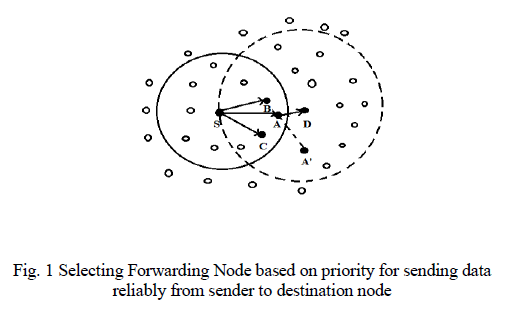 |
| Fig. 1 explains the criteria for selecting forwarding nodes.For a large dynamic mobile adhoc network,many intermediate hops are available between sender and receiver.Node which will be selected as a forwarder based on the following criteria:The forwarding node should make progress positively towards the destination.That is nodes in the forwarding area are allowed to be forwarder based on the priority.The maximum forwarding area is given by overlap of transmission circle of destination with radius equal to distance between sender and receiver and transmission circle of sender node.By this,it can be determined whether a node makes positive progress or not.Eventhough the nodes within coverage area are able to receive the signal,transmission of data packet will be in unicast manner. |
| Duplicate relaying is limited by the following:only the packet forwarded by the sender node and next-hop node are transmitted in an opportunistic method.Another criteria is that it should select a node as a forwarder which has less distance towards the destination.At the same time it should be within coverage area of sender node. |
| 2) Maintaining Forwarding Table: |
| Each node establishes forwarding table for forwarding the packets.The forwarding table is established during the transmission of packet.It is easier to maintain comparing to the routing table.The time taken to construct the forwarding table is easier since it is based on local neighbour information.For each flow of the packets, the forwarding table is constructed.Before creating a new forwarding node selection list, node will look up the existing forwarding table. |
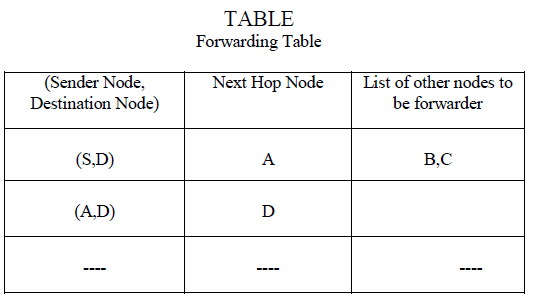 |
| B. Handling the Communication Void |
| Consider that the destination node is far away from sender node.Suppose if there are no intermediate nodes that makes positive progress towards destination, within senderâÃâ¬ÃŸs coverage area,then handling such situation becomes difficult.In order to transmit data,it will switch to void handling mode.A node is called as void noid,which tries to route the packet to the destination in some other way.That is it may pass through region that doesnâÃâ¬ÃŸt make positive progress towards the destination.But somehow the data will be delivered to the intended destination. |
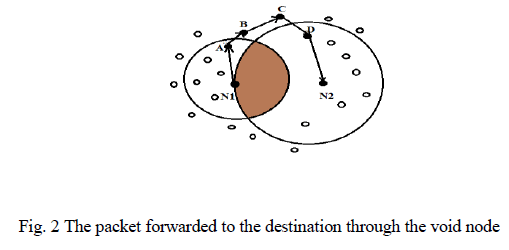 |
| Here node „N1âÃâ¬ÃŸ which acts as sender node has no such forwarder within coverage area that progresses in a positive direction to the receiver „N2âÃâ¬ÃŸ.But node „N1âÃâ¬ÃŸ can deliver the data to the receiver in some other direction.Thus node „N1âÃâ¬ÃŸ is called as void node and the packet will route around the void area.In Fig.2 it shows that it will route through many hops of the nodes A,B,C,D.Thus the path followed here is N1-A-B-C-DN2. The shaded portion describes the void area.Eventhough sender is closer to destination,it canâÃâ¬ÃŸt pass through positive direction.By Fig.2, it is clear that benefit of greedy forwarding cannot be obtained since it routes through the path that is not optimal. |
| The packets can be transmitted in an opportunistic manner while handling communication void.This can be done by introducing a virtual destination node.This can be placed in the circumference of the void node with radius larger than original radius.Here the radius is taken as length of network diameter.By this, the forwarding area can be extended than to the original.So it will be able to handle all type of communication voids. |
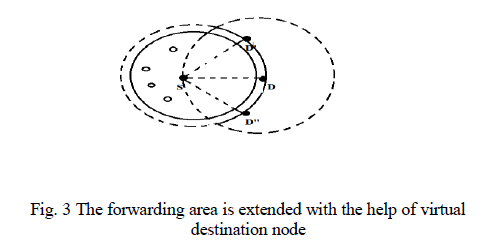 |
| Forwarding areas are extended by assuming virtual destination node.This can be explained clearly in Fig. 3.First finding the distance between sender and destination.Then taking this as radius of a void node and virtual destination (DâÃâ¬ÃŸ or DâÃâ¬ÃŸÃ¢Ãâ¬ÃŸ) may be in the circumference of this new transmission circle that progress in a positive direction to reach destination.Thus even in the situation of void, data will be delivered correctly towards the destination through virtual destination node. |
| C. Benefits of Location based Opportunistic Routing Protocol |
| End-to-End routes need not be maintained since due to the mobility of nodes, paths are established at the moment of forwarding the data. |
| If the highest priority forwarder fails to forward the packet, then the lower priority candidate that satisfies the criteria to the level best will forward the packet.Thus the delay is reduced by opportunistic routing and duplicate forwarding caused by repairing the route also reduced. |
| Opportunistic routing is achieved while handling the communication void. |
ALGORITHM |
| A. Forwarding Node Selection Algorithm |
| The algorithm used here is forwarding node selection algorithm.It is used to select the forwarding node.It is also used to make priority among nodes that are available. |
| List N: Neighbour List |
| List S: Forwarding node Selection List |
| D : Destination Node |
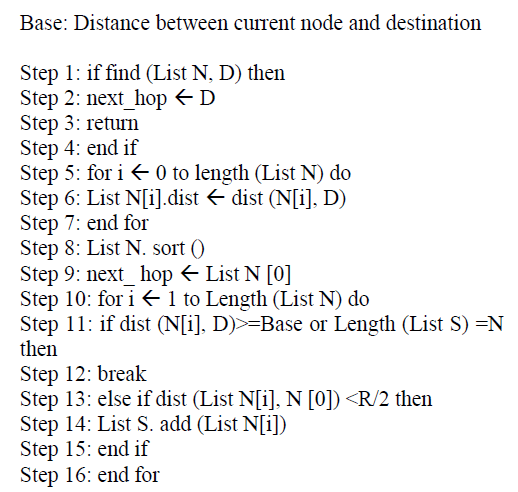 |
| Steps 1 to 4 indicates that if the destination node is very closer to the sender node, then directly next hop takes place to the destination node and the communication between sender and receiver takes place.Steps 5 to 8 explains that there are many neighbouring nodes.Choosing the priority among neighbouring nodes are based on distance information.The node which is closer to destination has higher priority compared to other nodes.Thus the priority list among the neighbouring nodes are made and it is sorted from higher priority to lower priority. |
| Steps 9 to 12 depict one of the criteria for selecting forwarding node. The forwarding node which is chosen now acts as Sender and again prioritization among neighbouring nodes takes place.The above steps explains that, for any node, its neighbouring nodes are spread anywhere in the region.If the neighbouring node has larger distance than any other candidate nodes distance, then that neighbouring node will not considered as next hop node.It clearly depicts that node which has positive progress towards destination is considered. |
| Steps 13 to 16 depicts that neighbouring node of sender node should be within half the radius of region of that sender node.If neighbour node is within that region,then that node can be added to forwarding node selection list.By this,communication void can be avoided.Thus this algorithm is used to select and prioritize forwarding node. |
| B. Forwarding Node Selection Criteria |
| Thus the forwarding nodes are selected based on the following criteria: Forwarding Node should have less distance towards the destination compared to other neighbouring nodes. At the same time, it should be within half the radius of the region of the sender node. |
EXPERIMENTAL RESULTS |
| Initially the mobile nodes are created and the distance of candidate nodes are calculated from the receiver.The following clearly explains the selection of forwarding node.Here considering sender node,receiver node and many intermediate nodes A,B,C,D,E,F,G,H,I,J,K. |
| The selection of forwarding node and routing towards the destination node is clearly explained in Fig.4. Among the nodes A, B, C and D, A has highest priority.So A is chosen as next hop node. |
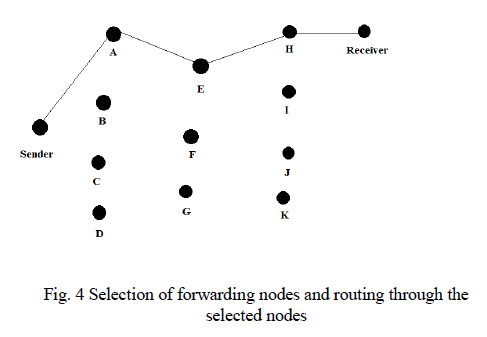 |
| Then according to the algorithm, among the nodes E, F, G, E which has the highest priority are chosen as next hop nodes and the packet is transmitted to the node E. Then H attains highest priority and it has destination as one-hop neighbour. So packet is transmitted to H and then receiver. |
| Since the position of the destination varies dynamically, routing takes place through different relay based on priority information specified in the algorithm.The destination position moves to new location, again the algorithms are implemented and route through the path which progresses the best towards the destination. |
| But it takes more time to deliver the packet reliably towards the intended destination since the forwarder is chosen such that it is closer to the destination. In future, it can be overcome by choosing the forwarder nearer to sender and each node knows the two-hop neighbours using Neighbour based Edge Forwarding approach thereby it will transmit the packet faster and in reliable manner towards the destination. |
| Fig. 5 explains clearly that the packet transmission is reliable and it will have faster packet transmission when choosing the forwarder closer to sender. Initially sender contains the packet and it has to reach the destination reliably and faster. Here considering nodes A, B, C and D are within coverage area, C is chosen as forwarding node. Each node maintains the two-hop neighbours list that are within the coverage area. According to this, the node K is closer to the node C. So it will transmit the packet faster compared to the existing method since it maintains only the list of one hop neighbour information. Finally the receiver node is within coverage area of node K, so it will transmit the packet reliably and faster towards the intended destination. |
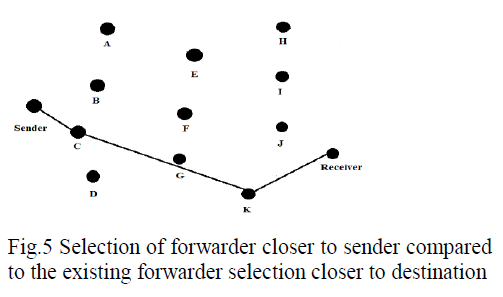 |
CONCLUSION |
| Thus the data will be delivered reliably towards the destination.If there exists a failure of delivering packet to the highest priority candidate or takes more time than normal average time to forward to highest priority, then it will choose lower priority candidate and forward the data reliably. |
| This protocol chooses the forwarding node as node which has less distance towards the destination compared to other nodes. This will cause delay in delivering the packet reliably towards the destination. In future, this can be overcome by selecting the forwarder closer to sender. Normally it takes less time to forward the packet to well known nearer node rather than the node which is far away. If every node knows its one-hop neighbourhood position, it will also cause more time to forward the packet. So here every node is made to know its location and its two-hop neighbour position thereby reducing overload caused by redundant transmissions in existing method and achieving faster and reliable delivery of packet to the destination. |
References |
|